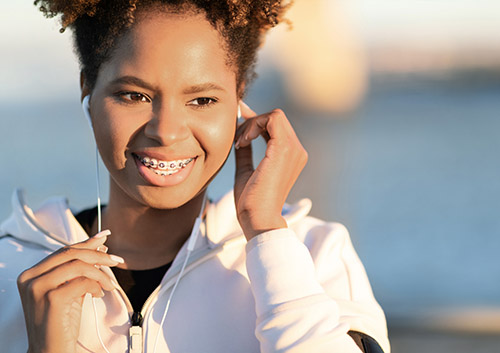Tips for a Braces-Friendly Thanksgiving
November 26th, 2025

If it’s your first Thanksgiving dinner with braces, you might be a bit nervous. After all, broken brackets and wires can take the fun right out of feasting!
Thankfully, we can help make your holiday meals more enjoyable with some menu tips for braces-friendly foods.
#1 Be Choosy about Snacks
Thanksgiving is often more than one meal—it’s a whole day of nibbling. Just be sure to enjoy snacks which are safe for your brackets and wires while you wait for the turkey to make its appearance. Avoid foods like crunchy raw vegetables, nuts, popcorn, and chips, which can be hard on your braces. Instead, go for the softer selections on the appetizer tray:
- Sliced and cubed fruits
- Soft breads
- Deviled eggs
- Spreadable or thinly sliced cheeses
- Meatballs
- Thinly sliced, soft deli meats
#2 Tweak Tradition as Needed
Some items on the traditional menu can be enjoyed as is, and some can be safely eaten with just a bit of tweaking.
- Creamy mashed potatoes and gravy are good to go
- Soft-cooked vegetables are easy on braces and filled with nutrients
- Turkey and ham are safe if you cut the meat from the bone and into bite-size pieces
- Choose jellied cranberry sauce instead of crunchy versions
- Stick to the soft, non-crunchy parts of dressing or stuffing and add some gravy for moisture
- Enjoy rolls and bread without nuts or hard crusts
#3 Don’t Forget Dessert!
Luckily for us, many of our favorite Thanksgiving desserts are easy on braces. Delicious, braces-friendly choices include:
- Pumpkin pie
- Cheesecake
- Apple pie with ice cream
- Soft cakes
- Puddings
- Soft truffles
Which desserts should wait until you’re finished with your orthodontic treatment? Nutty and chewy desserts and candies like pecan pie and caramels can cause loose or damaged braces, so it’s a “No, thank you” this year to the sticky, crunchy, and chewy items on the dessert buffet.
#4 Good Dental Hygiene Doesn’t Take Holidays Off
Holidays are busy, with shared meals and travelling and get-togethers in Chicago, IL. But it’s still essential to make time for proactive dental care, especially now that you wear braces.
Food which gets stuck in your brackets and wires isn’t just annoying, it’s also bad for your tooth enamel. When food sticks around, the bacteria in plaque use those sugars and carbs to create acids which erode teeth and lead to cavities. And since Thanksgiving day is often filled with nibbling on foods high in sugars and carbs, your teeth might need some extra TLC throughout the day.
- If you’re home, brush and floss as usual after eating. If you’re travelling, bring a kit with a travel-size toothbrush and toothpaste and some floss to keep your braces and teeth clean and your breath fresh throughout the day.
- If you’ve been eating acidic foods, wait about 30-60 minutes to brush. Acids weaken enamel temporarily, and, until the enamel rehardens, brushing can be abrasive.
- Hydrate with water. Water helps wash away food particles from teeth and braces and helps neutralize enamel-damaging acids in foods like cranberry sauce and sodas.
The team at Seder Orthodontics wants you to have a wonderful holiday with family and friends while you’re on your way to a beautiful, healthy smile. If you have any questions on just which foods should and shouldn’t be on your menu this Thanksgiving, talk to Dr. Karen Seder to discover the best ideas for stress-free holiday feasting.




 Website Powered by Sesame 24-7™
Website Powered by Sesame 24-7™